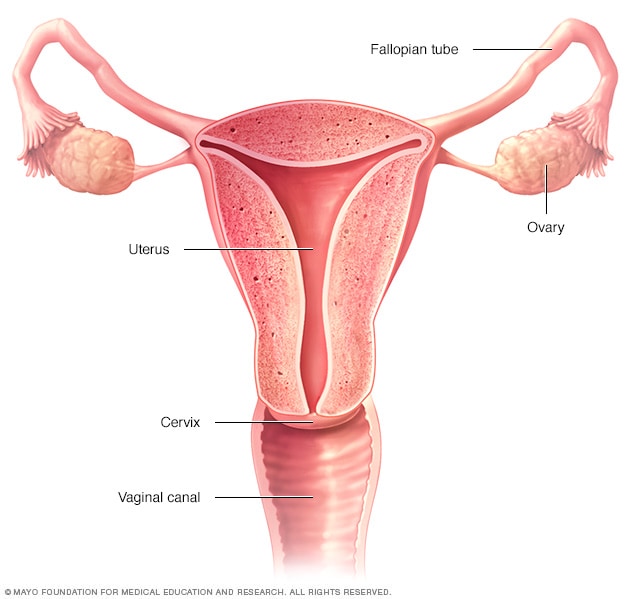Overview
Female reproductive system

Female reproductive system
The ovaries, fallopian tubes, uterus, cervix and vagina, also called the vaginal canal, make up the female reproductive system.
Mittelschmerz is one-sided, lower abdominal pain associated with ovulation. German for "middle pain," mittelschmerz occurs midway through a menstrual cycle — about 14 days before your next menstrual period.
In most cases, mittelschmerz doesn't require medical attention. For minor mittelschmerz discomfort, over-the-counter pain relievers and home remedies are often effective. If your mittelschmerz pain is troublesome, your doctor may prescribe an oral contraceptive to stop ovulation and prevent midcycle pain.
Products & Services
Symptoms
Mittelschmerz pain usually lasts a few minutes to a few hours, but it may continue for as long as a day or two. Pain from mittelschmerz may be:
- On one side of your lower abdomen
- Dull and achy, similar to menstrual cramps
- Sharp and sudden
- Accompanied by slight vaginal bleeding or discharge
- Rarely, severe
Mittelschmerz pain occurs on the side of the ovary that's releasing an egg (ovulating). The pain may switch sides every other month, or you may feel pain on the same side for several months.
Keep track of your menstrual cycle for several months and note when you feel lower abdominal pain. If it occurs midcycle and goes away without treatment, it's most likely mittelschmerz.
When to see a doctor
Mittelschmerz rarely requires medical intervention. However, contact your doctor if a new pelvic pain becomes severe, if it's accompanied by nausea or fever, or if it persists — any of which could indicate you have a condition more serious than mittelschmerz, such as appendicitis, pelvic inflammatory disease or even an ectopic pregnancy.
Causes
Mittelschmerz occurs during ovulation, when the follicle ruptures and releases its egg. Some women have mittelschmerz every month; others have it only occasionally.
The exact cause of mittelschmerz is unknown, but possible reasons for the pain include these:
- Just before an egg is released with ovulation, follicle growth stretches the surface of your ovary, causing pain.
- Blood or fluid released from the ruptured follicle irritates the lining of your abdomen (peritoneum), leading to pain.
Pain at any other point in your menstrual cycle isn't mittelschmerz. It may be normal menstrual cramping (dysmenorrhea) if it occurs during your period, or it may be from other abdominal or pelvic problems. If you have severe pain, see your doctor.
Risk factors
Mittelschmerz has no clear risk factors. But it may be more likely to happen between the ages of 15 and 25.
Complications
Mittelschmerz doesn't lead to other health conditions, also called complications. The pain goes away on its own, or with medicine or home remedies.
Prevention
Mittelschmerz can't be prevented. It's linked with natural changes in the body that happen during the menstrual cycle.
Ovulation is the release of an egg from one of the ovaries. It often happens about midway through the menstrual cycle, although the exact timing may vary.
In preparation for ovulation, the lining of the uterus, or endometrium, thickens. The pituitary gland in the brain stimulates one of the ovaries to release an egg. The wall of the ovarian follicle ruptures at the surface of the ovary. The egg is released.
Finger-like structures called fimbriae sweep the egg into the neighboring fallopian tube. The egg travels through the fallopian tube, propelled in part by contractions in the fallopian tube walls. Here in the fallopian tube, the egg may be fertilized by a sperm.
If the egg is fertilized, the egg and sperm unite to form a one-celled entity called a zygote. As the zygote travels down the fallopian tube toward the uterus, it begins dividing rapidly to form a cluster of cells called a blastocyst, which resembles a tiny raspberry. When the blastocyst reaches the uterus, it implants in the lining of the uterus and pregnancy begins.
If the egg isn't fertilized, it's simply reabsorbed by the body — perhaps before it even reaches the uterus. About two weeks later, the lining of the uterus sheds through the vagina. This is known as menstruation.
Feb. 13, 2024